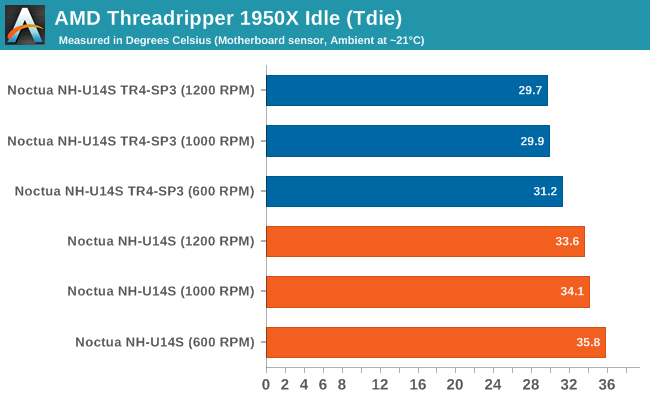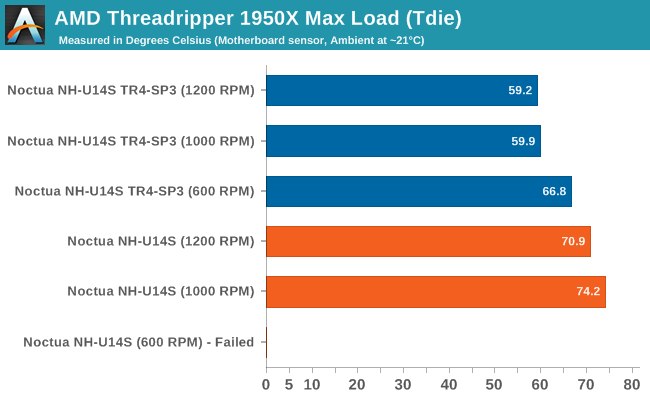Analyzing Threadripper Thermals: Big Base Cooling Wins
by E. Fylladitakis on March 14, 2018 8:30 AM EST- Posted in
- CPUs
- AMD
- Cases/Cooling/PSUs
- Noctua
- ThreadRipper
- 1950X
- CPU cooler
Test Methodology
Our test system appears in the following table:
| Test Setup | |
| Processor | AMD Threadripper 1950X 16 Cores, 32 Threads, 3.4 GHz |
| Motherboards | Gigabyte X399 Designare EX |
| Cooling | Noctua NH-U14S / NH-U14S TR4-SP3 |
| Power Supply | Corsair AX1200i Platinum PSU |
| Memory | Corsair Vengeance LPX 4 × 8GB kit |
| Memory Settings | 2666 MHz |
| Video Cards | MSI GTX 770 Lightning 2GB (1150/1202 Boost) |
| Hard Drive | Crucial MX200 1TB |
| Case | Open Test Bed |
| Operating System | Windows 10 64-bit |
For both tests, we used Noctua NT-H1 thermal grease on the processor. For the thermal grease to settle in, the processor was loaded for at least an hour, left to rest for at least two hours, loaded again, then left to rest overnight. The results were recorded on the next day. After the first tests, the CPU was thoroughly cleaned and the process was repeated for the second cooler.
By default, the motherboard is trying to control the speed of the cooler’s fans depending on the processor’s temperature, creating a variable environment. As we are trying to showcase what the difference between full and partial contact for the exact same cooling arrangement, we needed a stable environment, i.e. the fans had to be running at the exact same speed. Therefore, we are powering the fans from an external power source, maintaining stable RPM throughout our testing.
Finally, we are always monitoring and recording the Tdie temperature. That is a more accurate representation of the CPU's actual thermal state, as the Threadripper (and some Ryzen) cores report their operational temperatures with a large positive offset (+27°C) for control purposes.
Results
Starting off with idle temperatures, we're already seeing a difference between the two coolers. At all fan speeds, the larger-based TR4 model cooler is around 4C cooler than its standard counterpart. Given just how little power a Threadripper processor actually uses at idle, this is an interesting prelude of things to come.

Meanwhile under load, not only there is a clear difference on the performance of the two CPU/Cooler arrangements, but that difference is much more than merely significant. The figures that we recorded correspond to a major cooling upgrade. The standard NH-U14S can barely maintain our Threadripper 1950X functional under load, with the system throttling very heavily at all times.

With its fan's speed lowered down to 600 RPM, the NH-U14S could not handle the thermal load (hence the missing data point in the graph). Meanwhile although it is essentially the same cooler, the NH-U14S TR4-SP3 manages to maintain operational temperatures throughout all our tests, with no thermal throttling even with its fan's speed lowered down to 600 RPM. If we were examining two different coolers, such an improvement would easily differentiate a basic from an advanced air cooler. In our case, the two coolers are identical, yet the difference of the arrangement’s thermal conductance is substantial, all because of the cooler’s contact plate.
The following figure displays the CPU’s temperature over time with a script loading and unloading the processor every 10 seconds. The fans are running steady at 1200 RPM. It can be seen that the NH-U14S TR4-SP3 offers both better thermal performance than the standard version with the mounting kit, but also is more resilient to varying thermal loads.











43 Comments
View All Comments
Ryan Smith - Wednesday, March 14, 2018 - link
To clarify, the title of page 2 is a bit of humor. E. isn't a doctor (though Ian is).LordanSS - Wednesday, March 14, 2018 - link
Thank you for the article. It was a good read with the thermodynamics explanation as well.fackamato - Wednesday, March 14, 2018 - link
What are the decibels during load for each cooler/rpm?Valantar - Wednesday, March 14, 2018 - link
A fascinating read. Now for the follow-up: an article where you test sticking two 212 Evos side by side on a Threadripper. That should cover most of the IHS, no?LanceLLandon - Wednesday, March 14, 2018 - link
My preference is Peltier air cooling. By cooling a processor slightly frozen less thermal noise is generated and less miscalculations are performed. Perhaps this is more important for studio Sound Recording and Mixing/Editing or Movie Video Editing or for Work Station performance. If I am going to all the trouble to build a multi core computer I will also so go to the trouble of cooling it far more effectively.MrSpadge - Wednesday, March 14, 2018 - link
A Peltier cooler will help you with extreme OC, if sized properly, but apart from that will only increase your energy consumption significantly. If you want lower temperatures go for chilled water, that's far more efficient. But you absolutely don't need that. Otherwise all the servers in data centers, DELL shops etc. would have to be constructed differently. And if you really want to reduce the chance of calculation errors beyond the manufacturer specification, simply drop the CPU clock by 100 MHz.BTW: are you using ECC RAM? Not that I'm recommending it for home computers, but if not you're definitely overshooting with that Peltier and should care for more probable points of failure first.
Crazyeyeskillah - Wednesday, March 14, 2018 - link
Water or GTFO.master381 - Wednesday, March 14, 2018 - link
Nice article!A question - on Page 3, is this supposed to read " absolute thermal resistance of the cooler itself needs to be very *low,*" instead of high?
Excerpt:
"The high thermal resistance caused by an undersized contact plate cannot be easily countered, which is why the absolute thermal resistance of the cooler itself needs to be very high, i.e. why AMD’s cooler recommendations are so over the top."
Ryan Smith - Thursday, March 15, 2018 - link
That was meant to read "thermal conductance". Thanks!zodiacfml - Wednesday, March 14, 2018 - link
The conclusion I can get from here is that desktop CPU with around 90W TDP can also benefit from the larger surface area, considering the differences in temps at idle of the TR chip.